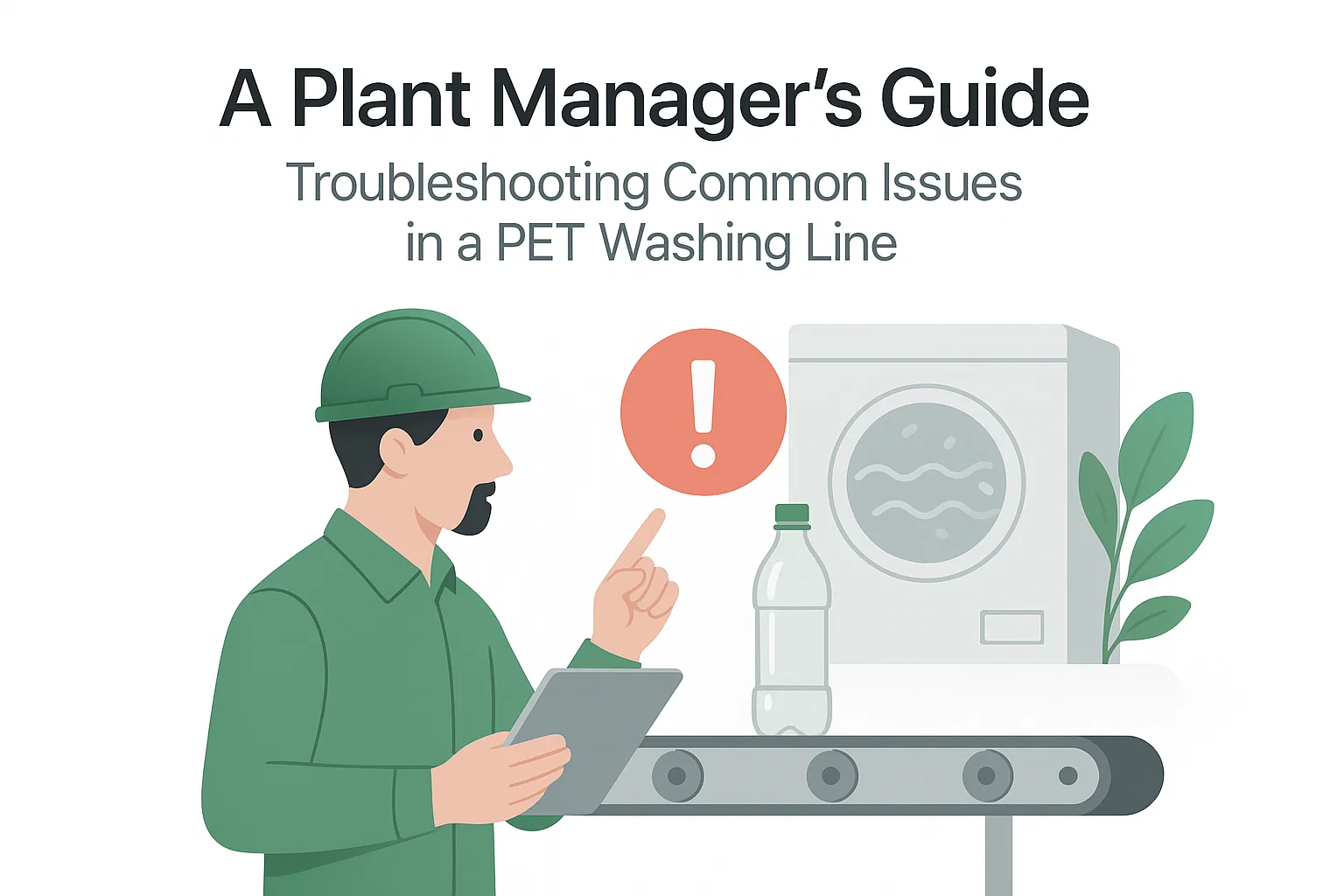Een moderne Waslijn voor PET-flessen is een robuust en betrouwbaar systeem, ontworpen voor continue, hoge doorvoer. De realiteit van de dagelijkse productie zorgt er echter voor dat zelfs de best presterende fabrieken operationele uitdagingen kunnen tegenkomen. Het proactief identificeren en oplossen van deze problemen is essentieel om de efficiëntie te behouden, de kwaliteit van het eindproduct te garanderen en uw winstgevendheid te beschermen.
In deze praktische gids worden drie van de meest voorkomende problemen voor fabrieksmanagers behandeld: verstoppingen, een hoog vochtgehalte en geuren. De gids biedt een kader voor diagnose en effectieve oplossingen.
1. Probleem: materiaalblokkades en inconsistente stroming
Een soepele, consistente materiaalstroom is de levensader van een recyclinglijn. Elke onderbreking kan leiden tot kostbare stilstand en een lagere productie.
Veelvoorkomende oorzaken en diagnose:
- Ineffectief balen breken: Als de balenbreker de samengeperste flessen niet grondig scheidt, kunnen grote klonten verstoppingen in de volgende trechters en transportbanden veroorzaken.
- Granulator overbelasting: Het sneller invoeren van materiaal in de granulator dan het verwerkt kan worden, is een belangrijke oorzaak. Dit kan ook worden verergerd door botte messen of messen met een verkeerde opening, die minder efficiënt versnipperen en meer wrijving veroorzaken.
- Transportbandsnelheid komt niet overeen: Een transportband die een machine sneller voedt dan de verwerkingscapaciteit ervan, leidt onvermijdelijk tot overstromingen en verstoppingen.
- Hechting van nat materiaal: In latere stadia, met name in cyclonen en leidingen, kunnen vlokken met overmatige vochtigheid aan oppervlakken blijven plakken, zich in de loop van de tijd ophopen en een verstopping veroorzaken.
Oplossingen en preventieve maatregelen:
- Operatorsopleiding: Zorg ervoor dat uw personeel is getraind in het in een gelijkmatige, juiste snelheid invoeren van balen en het herkennen van de signalen van een overbelaste granulator.
- Onderhoudsschema voor messen: Implementeer en houd je aan een strikt schema voor het controleren, slijpen en roteren van granulatormessen. Scherpe, correct afgestelde messen verbruiken minder vermogen en verwerken het materiaal soepeler.
- Systeemkalibratie: Controleer regelmatig of de snelheid van alle transportbanden correct is afgestemd op de verwerkingscapaciteit van de machines die ze aanvoeren.
- Controleer de droogefficiëntie: Als er na het wassen verstoppingen ontstaan, controleer dan de ontwaterings- en droogfases om er zeker van te zijn dat het materiaal niet met te veel vocht wordt getransporteerd.
2. Probleem: Hoog vochtgehalte in de uiteindelijke vlokken
Overschrijding van het gewenste vochtgehalte (meestal <1%) is een kritieke kwaliteitsfout. Overtollig vocht leidt tot hydrolytische degradatie tijdens de extrusie, wat de intrinsieke viscositeit (IV) en de structurele integriteit van het eindproduct ernstig in gevaar brengt.
Veelvoorkomende oorzaken en diagnose:
- Ondermaatse prestaties van mechanische ontwatering: Het filter in een centrifugaaldroger kan na verloop van tijd verstopt raken met fijn stof of slijten, waardoor de efficiëntie afneemt. Overbelasting van de machine verhindert ook dat het water effectief wordt afgevoerd.
- Onvoldoende thermische droging: Dit kan verschillende oorzaken hebben:
- Lage temperatuur: De temperatuur in de heteluchtdroger is mogelijk te laag ingesteld.
- Korte verblijftijd: Het materiaal stroomt mogelijk te snel door de droogbuizen, waardoor er te weinig contacttijd is met de hete lucht. Dit is vaak te wijten aan een te hoge toevoersnelheid.
- Lage luchtstroom: Een verstopt filter of een slecht presterende ventilator kan de hoeveelheid warme lucht verminderen, waardoor verdamping wordt belemmerd.
Oplossingen en preventieve maatregelen:
- Regelmatig schermonderhoud: Controleer en reinig regelmatig het scherm in uw centrifugaalontwateringsmachine.
- Controleer thermische drogerinstellingen: Controleer regelmatig of de temperatuurregelaar nauwkeurig is en of de ventilator op het aangegeven vermogen functioneert.
- Optimaliseer de invoersnelheid: De gehele lijn moet in balans zijn om ervoor te zorgen dat de thermische droger het materiaal met een snelheid ontvangt die volledige droging mogelijk maakt. Dit is het meest voorkomende punt van falen.
- Controleer de omgevingsomstandigheden: Houd er rekening mee dat een zeer hoge luchtvochtigheid soms van invloed kan zijn op het uiteindelijke droogresultaat. Kleine aanpassingen in de temperatuur of de verblijftijd zijn mogelijk nodig.
3. Probleem: blijvende geuren in het eindproduct
De uiteindelijke PET-vlokken moeten schoon en neutraal zijn. Een achtergebleven chemische of organische geur wijst op een inefficiëntie van het wasproces en kan leiden tot productafkeuring.
Veelvoorkomende oorzaken en diagnose:
- Onvoldoende hete was: Dit is de meest voorkomende oorzaak. De hete reiniger is verantwoordelijk voor het verwijderen van lijm, olie en organische resten (bijvoorbeeld uit sap- of melkflessen). Als de temperatuur te laag is, de dosering van de chemische (bijtende) stoffen onjuist is of de inwerktijd te kort is, worden deze verontreinigingen niet volledig verwijderd.
- Verontreinigd proceswater: In gesloten systemen kunnen bacteriën en opgeloste verontreinigingen zich ophopen en zich opnieuw op de vlokken afzetten als de waterfiltratie en -behandeling niet adequaat zijn.
- Verontreiniging van bronmateriaal: Bepaalde verontreinigingen in de eerste balen, zoals andere kunststoffen (PVC) of overtollig organisch materiaal, kunnen zeer moeilijk te verwijderen zijn en vereisen mogelijk gespecialiseerde procesaanpassingen binnen uw PET-kunststofrecyclingsysteem.
Oplossingen en preventieve maatregelen:
- Optimaliseer de Hot Wash-fase: Titreer regelmatig en controleer de chemische concentratie. Controleer de nauwkeurigheid van de temperatuurmeters. Zorg ervoor dat de hogesnelheidsroerder correct functioneert voor mechanische reiniging.
- Implementeer een waterbeheerprogramma: Reinig filters regelmatig en controleer de kwaliteit van uw proceswater. Een goed onderhouden waterbehandelingssysteem is cruciaal voor een hoogwaardig eindproduct.
- Verbeter voorsortering: Verbeter de kwaliteitscontrole van binnenkomende balen door zwaar vervuilde items of duidelijke niet-PET-verontreinigingen te verwijderen voordat ze de hoofdwaslijn ingaan.
Uw partner in productie
Proactief onderhoud en een diepgaand begrip van het proces vormen de basis voor een succesvolle recyclingoperatie. Door deze veelvoorkomende uitdagingen te anticiperen, kunt u ervoor zorgen dat uw installatie optimaal presteert.
Bij Energycle ontwerpen we onze systemen voor betrouwbaarheid en operationele eenvoud, en ontwikkelen we oplossingen die juist deze problemen minimaliseren. Voor verdere technische ondersteuning of meer informatie over onze robuuste en efficiënte PET-waslijnenNeem vandaag nog contact op met ons engineeringteam.



